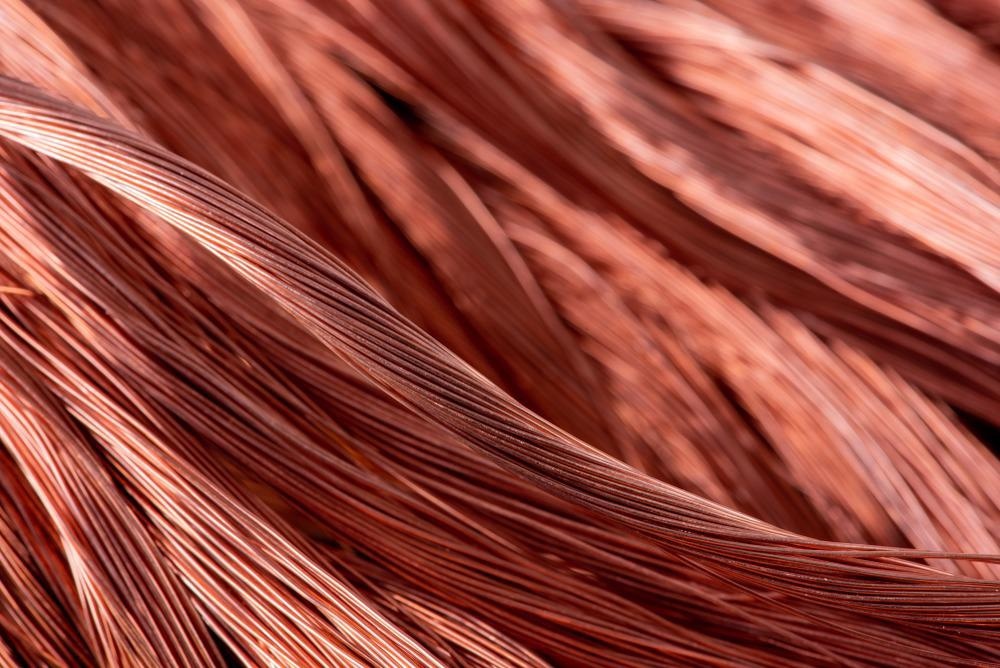Thermal conductivity plays a critical role within semiconductor technology; to meet the needs required for this ever-evolving industry, novel materials that improve thermal conductivity are paramount. Metal nanowires such as copper nanowires have been reported to significantly enhance the thermal conductivity of polymers, and may be an innovative addition to advance the semiconductor industry.

Image Credit: FlashMovie/Shutterstock.com
Copper nanowires may be significant for electronic devices due to the size of the nanowires market, which is estimated to grow at a rate of 25.10% between the years 2020 to 2027. This innovative technology will aid in meeting the demand for higher and more efficient electronic devices, raising both consumer success and industrial profit.
This article will provide an overview of copper nanowires and their use within the semiconductor industry.
The use of copper nanowires (CuNW), which are similar to conventional macroscale wires but reduced to a nano size, are usually less than 100 nanometers in diameter but can be more than 1000 times longer.
The abundance of copper as well as its conductive properties make this metal an attractive material for applications such as macroscale electrical wires. Copper is 6% less conductive than silver, which is thought to be the most conductive element but is 1000 times more abundant. Copper can therefore be seen to be more useful.
Microprocessors, which utilize copper-based interconnects, were first introduced in 1997. Since this introduction, the use of copper for scaling electronic structures to a nanoscale has been critical.
Properties such as high conductivity and its resistance to electromigration further drive the significant role that copper plays within electronic devices.
Key Properties That Enhance Semiconductor Efficiency
Properties such as being ductile, malleable, and having high conductivity levels enable copper to hold a high value within semiconductor fabrication. Within semiconductors, copper is used as an interconnect material that holds a significant role in power supply and electric signal distribution.
The frequency at which transistors can turn on and off determines the processor speed limit and chip performance; to increase clock frequency, the transistor size would need to be reduced.
The speed limit and performance of a chip can also be determined by signal propagation delays, the time constant of copper interconnects, the thermal properties of the device material, and more.
Copper interconnects are used in integrated circuits to reduce propagation delays and power consumption. As copper is a better conductor than aluminum, it replaced the less conductive metal as an interconnect material two decades ago due to its higher thermal and electrical conductivity.
The use of copper wires is more beneficial than aluminum due to being able to conduct electricity with approximately 40% less resistance, which aids in increasing microprocessor speed by 15%. This highly conductive material also has a higher level of durability and is more reliable over time, as well as having the capacity to be reduced to a nano-size for further applications.
Additionally, the utilization of copper within interconnects enables interconnects with narrower dimensions, as well as requiring less energy to pass electricity.
These properties have allowed copper interconnects to become an industry standard, enabling innovations with smaller and faster microprocessors, which would be of benefit to the semiconductor field.
Current Challenges of Semiconductors and Thermal Conductivity
As the semiconductor industry is advancing, the development of electronics is dependent on smaller and more compact components which require high power and performance. However, a challenging obstacle that needs overcoming includes temperature sensitivity, as well as control over materials to provide cooling to ensure optimum performance and operation.
Additionally, due to the small surface area of innovative minuscule devices, heat transfer can be difficult.
An investigation by Peng, Chen, and Lu (2021) analyzed the electrical resistivity and thermal conductivity of single CuNWs, where they had used the Bloch–Grüneisen formula to understand the mechanisms for the electrical resistivity.
They found high residual electric and thermal resistivity, which may be due to the strong structural scattering which was found on the electron transport at the copper–copper oxide interface.
The utilization of CuNWs could potentially aid with the advancement of semiconductors with the ability to manipulate the thermal conductivity of the material through the degree of structural scattering.
The results of the study suggested that structural scattering is high in electrical current transport as well as within heat transfer in nanowires. This could potentially revolutionize the way CuNWs are used within semiconductors, advancing the electronics industry further into the future.
Copper nanowires are the ideal candidate for micro and nanoscale electronics, which can be used for applications such as flexible and transparent electrodes, catalysts, and copper nano-interconnects.
However, while it has been used since 1997, it was only recently that a simple and reliable technique for the purpose of assembling copper nanowires into functional devices has been developed.
Producing Copper Nanowires and the Future
The production of these nanomaterials has previously been a challenge, with the traditional method of producing copper nanowires including the dual damascene process. However, with innovative research, novel approaches that are more simple and more cost-efficient are being investigated.

Image Credit: Flegere/Shutterstock.com
The magnetic field-assisted assembly technique is a novel method that is a simpler and less expensive approach to producing CuNWs. It includes using an external magnetic field to direct the assembly of magnetically active nanowires that are suspended within a solution.
This technique assembles the nanowires within a chain-like structure, providing a continuous network with variable lengths.
Additionally, NASA has also recently developed novel technology that has the capability of producing copper nanowires directly. The innovative technology aims to simplify the technique of producing copper nanowires on a substrate without the challenges found through chemical synthesis.
This technique forms copper oxide nanowires from copper film, foil, or available copper wires through oxidation, which utilizes a vapor phase technique. To produce copper nanowires, the copper oxide nanowires are reduced within a hydrogen atmosphere at 400 degrees Celsius.
The efficacies of these copper nanowires produced by NASA were examined for differences in electrical characterization, which was found to have a decreased level of resistance by six orders of magnitude. The benefits of this technique include having a higher level of conductivity, low reflectivity, high absorption of visible light, and being simple and inexpensive.
This novel technology can be used for applications from advancing the semiconductor industry and technology used within electronic devices—which would ease the difficulties of consumers globally—to applications such as gas sensors or microheaters.
The possibilities for this innovative technology are endless, especially due to the critical role technology plays in society; with the nanowire market expecting to grow at a rate of approximately 25% between 2020 and 2027, this advancement will only aid with further novel developments.
While there is still undergoing research into optimization with simpler CuNW production methods and enhanced thermal conductivity within semiconductors, the potential of copper nanowires may be revolutionary.
Further Reading and References
Alahmad, M. and El-Aleem, F., (2003). Heat Transfer Challenges in Semiconductors Processing and the Applications of Heat Pipes for Efficient Heat Removal. Journal of King Saud University - Engineering Sciences, 15(1), pp.141-154. Available at: https://www.sciencedirect.com/science/article/pii/S1018363918307670
Eudaemonia. (2021). Nanowires Market: Forecast by Key Products, Types, Application, Regions and Overview of History - Eudaemonia.
Peng, W., Chen, F. and Lu, M., (2021). Thermal conductivity and electrical resistivity of single copper nanowires. Physical Chemistry Chemical Physics. Available at: https://pubs.rsc.org/en/content/articlelanding/2021/CP/D1CP02774C
Pdx.portals.in-part.com. (2021). Copper Nanowires for Semiconductor Interconnects. [online] Available at: https://pdx.portals.in-part.com/RQx7nm2a0ZeM
Technology.nasa.gov. (2021). Copper Nanowire Production for Interconnect Applications | T2 Portal. [online] Available at: https://technology.nasa.gov/
Ye, S., Stewart, I., Chen, Z., Li, B., Rathmell, A. and Wiley, B., (2016). How Copper Nanowires Grow and How to Control Their Properties. Accounts of Chemical Research, 49(3), pp.442-451. Available at: https://pubs.acs.org/doi/full/10.1021/acs.accounts.5b00506
Disclaimer: The views expressed here are those of the author expressed in their private capacity and do not necessarily represent the views of AZoM.com Limited T/A AZoNetwork the owner and operator of this website. This disclaimer forms part of the Terms and conditions of use of this website.